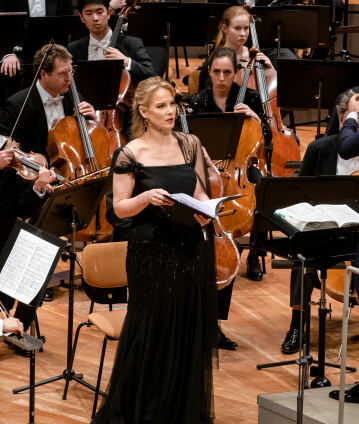Mahler’s Third Symphony with Elīna Garanča and Lorenzo Viotti

In his Third Symphony, Gustav Mahler gives musical form to elemental symbols of nature – including stories of flowers and animals – with which he creates a gigantic world panorama, culminating in a hymn of overwhelming beauty. In this performance we hear Lorenzo Viotti, who steps in for Yannick Nézet-Séguin, and Elīna Garanča, who not only has “beauty of voice, but also that indefinable magic called charisma” (The Telegraph).
“Nothing came of the profound interrelationships between the various movements which I had originally dreamed of,” Gustav Mahler wrote about his Third Symphony in 1896. The self-critical comment was by no means an indication that Mahler was dissatisfied with the composition, but rather reflected the many modifications he had made to the work during its composition. Mahler initially intended that the last movement of his Third Symphony would include a soprano solo. After he had already completed the composition to a large extent, with numerous changes to the middle movements and a finale that deviated from his original plan for the work, the focus of his interest shifted to the first movement.
This movement confronted the composer with an “enormous undertaking” for which “I don’t think I should have had the courage, had the rest not already been completed”. The enormous proportions of the movement, which he juxtaposed as the “first part” with the other five movements combined as the “second part”, were unprecedented in the history of the genre. “I am almost afraid that even the faithful and initiated few will find it too much for them – this movement is so difficult, so incomprehensively vast, and developed in a polyphonic style that is new even to me,” Mahler said, voicing his doubts. “Whoever fails to comprehend it in terms of the Grand Manner will be like a dwarf faced with a mountain giant; at best, he will see details, but never grasp the whole.” In order to make it easier for his listeners to understand the music, Mahler supplied headings for the various movements, which he later discarded: “Pan awakes. Summer Marches in” – “What the Flowers in the Meadow Tell Me” – “What the Animals in the Forest Tell Me” – “What Man Tells Me” – “What the Angels Tell Me” – “What Love Tells Me.”
Despite Mahler’s misgivings, the premiere of the Third Symphony in Krefeld on 9 June 1902 was one of the composer’s greatest artistic successes during his lifetime. The Neue Zeitschrift für Musik described the audience’s reaction at the time: “It was no longer a mere celebration, it was an homage.”
© 2020 Berlin Phil Media GmbH
Related interviews
Artists
Our recommendations
- Simon Rattle and Elīna Garanča at the Baden-Baden Easter Festival
- Europakonzert from Prague with Sir Simon Rattle and Magdalena Kožená
- Gustavo Dudamel with Mahler’s Fifth Symphony
- A Czech evening with Magdalena Kožená and Tomáš Netopil
- Semyon Bychkov and Kirill Gerstein
- Simon Rattle and Patricia Kopatchinskaja